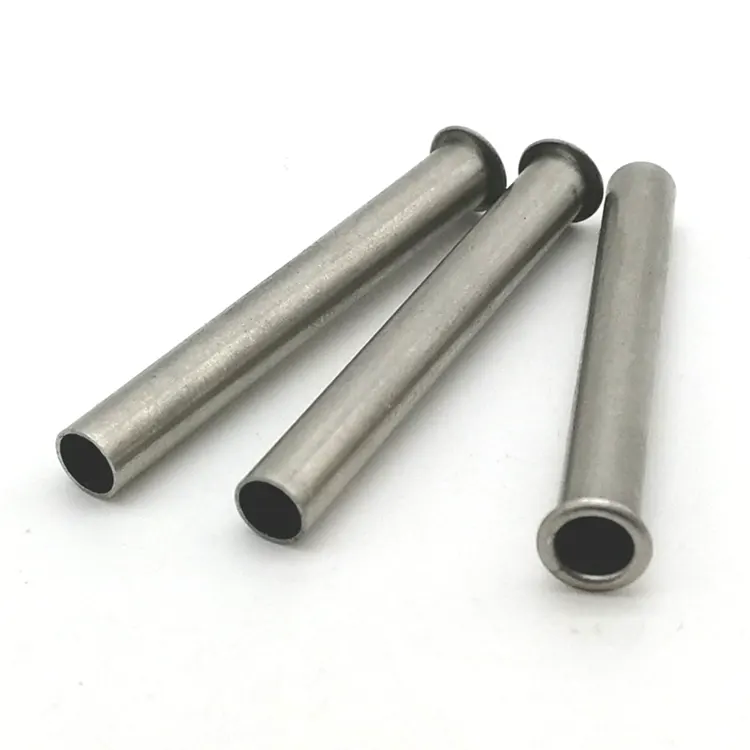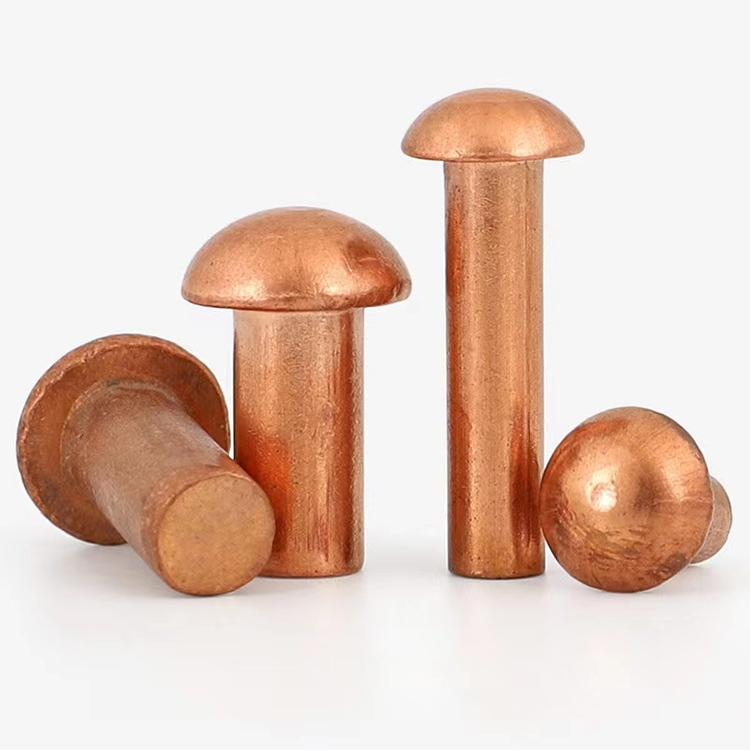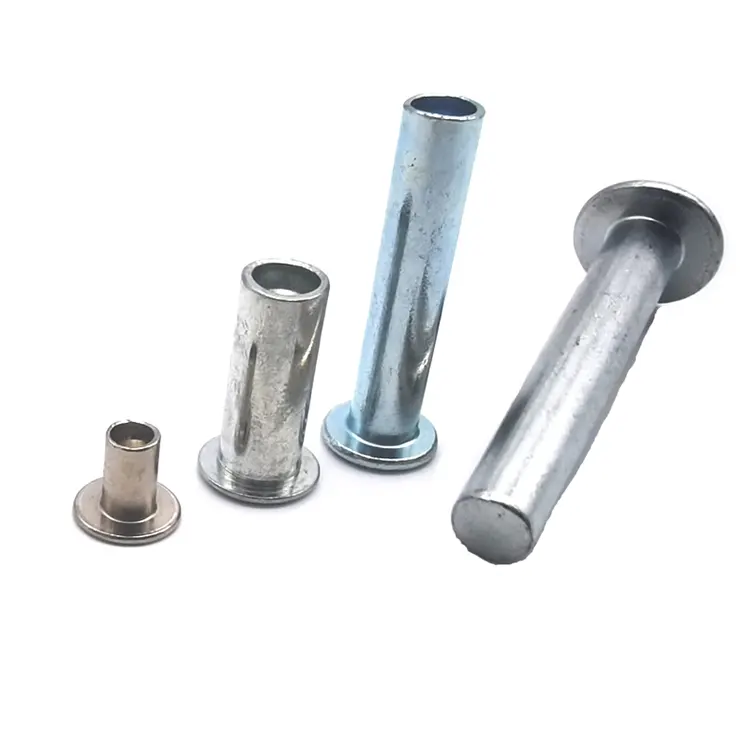Đinh tán đặc biệt
One of Chinese manufacturer of Special Rivets, offering excellent quality at a competitive price, is Notin. Feel free to get in touch.
In the field of mechanical manufacturing and assembly, rivets are a common fastener used to professionally connect two or more parts. According to the degree of standardization, rivets can be divided into two categories: standard rivets and non-standard rivets. The size, shape and material of standard rivets are uniformly specified, while non-standard rivets are customized according to specific needs. The following will introduce the characteristics and applications of non-standard rivets from multiple aspects.
What are non-standard rivets?
Non-standard rivets are also called special rivets. They refer to rivets that do not meet national standards or industry general standards. Their size, material, structure and other parameters are designed and manufactured according to the specific needs of customers. Due to the different connection requirements of different industries and equipment, standard rivets may not meet the requirements of certain special scenarios, so non-standard rivets came into being.
What are the characteristics of special rivets?
(1) Strong customization: Non-standard rivets can be personalized according to factors such as the use environment, stress conditions, and assembly methods to ensure that they perform well in actual applications.
(2) Diverse materials: In addition to common carbon steel and stainless steel, non-standard rivets can also be made of special materials such as aluminum alloy, copper alloy, titanium alloy, etc. to meet different corrosion resistance, strength and weight requirements.
(3) Flexible structure: The structure of non-standard rivets can be adjusted according to needs, such as head shape, stem diameter, length, etc., and can even be designed to be hollow, semi-hollow or other special shapes.
- View as
Đinh tán sắt
Đinh tán sắt hay còn gọi làđinh tán thép carbon, là một loại dây buộc thường được làm bằng thép cacbon với các phương pháp xử lý bề mặt như mạ kẽm. Chúng có độ bền kéo 400-500 MPa và phù hợp cho các ứng dụng như thiết bị điện. Để đáp ứng các ứng dụng tán đinh khác nhau, đinh tán sắt thường được sản xuất dưới dạng đinh tán bán rỗng hoặc đặc. Đinh tán sắt là một thành phần cơ khí cơ bản nhưng quan trọng, được sử dụng rộng rãi vì độ bền, giá cả phải chăng và dễ sử dụng.
Đọc thêmGửi yêu cầuĐinh tán đầu sắt
Đinh tán đầu chảo sắt, với các tính năng nhẹ, chống ăn mòn và mang tính thẩm mỹ, đã trở thành vật liệu đa năng linh hoạt trong sản xuất công nghiệp. Cho dù trong các ứng dụng quan trọng về trọng lượng hay trong cuộc sống hàng ngày, đinh tán đầu chảo bằng sắt đều mang lại hiệu suất và độ tin cậy vượt trội. Chào mừng bạn đến với Nuote Metals ở Đông Quan, Trung Quốc, chuyên gia về các loại đinh tán này. Chúng tôi cung cấp các sản phẩm chất lượng cao với giao hàng đảm bảo. Chúng tôi cũng sản xuất các phụ kiện phần cứng khác, chẳng hạn như khoen, bộ phận gia công và bộ phận được đóng dấu.
Đọc thêmGửi yêu cầuĐinh tán đầu nấm sắt
Nuote Metals là nhà sản xuất đinh tán chuyên nghiệp có trụ sở tại Đông Quan, Trung Quốc. Đinh tán đầu nấm sắt của chúng tôi, đúng như tên gọi, có đầu hình nấm với lõi bán rỗng hoặc lõi đặc. Đầu thường lớn hơn, mang lại bề mặt chịu lực tốt. Cấu trúc này cho phép biến dạng trong quá trình lắp đặt, thông qua ép đùn hoặc dụng cụ chuyên dụng, để kết nối an toàn hai hoặc nhiều vật liệu. Được làm bằng sắt, chúng thường được mạ kẽm hoặc xử lý bằng các chất hoàn thiện khác để chống ăn mòn.
Đọc thêmGửi yêu cầuĐinh tán đầu sắt phẳng
Là một đầu nối cơ khí thông thường, đinh tán đầu phẳng bằng sắt chiếm một vị trí quan trọng trong nhiều lĩnh vực công nghiệp do đặc điểm thiết kế và phạm vi ứng dụng rộng rãi. Về mặt cấu trúc, đầu đinh tán phẳng, hình đĩa và thân hình trụ. Phần cuối được xử lý đặc biệt để tạo thành một cấu trúc khó chịu. Sau khi lắp đặt, áp lực hoặc tác động làm cho phần thân nở ra, tạo thành sự ăn khớp cơ học với thành lỗ để đạt được hiệu quả siết chặt. So với đinh tán đầu tròn hoặc đinh tán đầu chìm, thiết kế đầu phẳng có lợi thế đáng kể về phân bố lực và diện tích tiếp xúc. Ví dụ, khi chịu lực cắt, đầu hình đĩa của nó có thể phân tán tải trọng đến một diện tích lớn hơn, giảm áp suất trên một đơn vị diện tích một cách hiệu quả.
Đọc thêmGửi yêu cầuĐinh tán đầu chìm bằng sắt
Đầu của đinh tán đầu chìm bằng sắt có hình dạng giống như một hình nón cụt, với hình nón thường nghiêng một góc 90° hoặc 120° so với trục của đinh tán. Hình dạng này cho phép đầu đinh tán nằm ngang bằng với bề mặt của bộ phận được kết nối sau khi lắp đặt, mang lại vẻ ngoài mịn màng. Điều này đặc biệt thích hợp cho các ứng dụng mà độ phẳng bề mặt là rất quan trọng. Hãy đến với Nuote Metals để tùy chỉnh chiếc đinh tán đầu chìm bằng sắt mà bạn mong muốn. Các kỹ sư của chúng tôi, với hơn 10 năm kinh nghiệm, rất quen thuộc với việc sản xuất các loại đinh tán khác nhau.
Đọc thêmGửi yêu cầuĐinh tán nửa hình ống
Đinh tán nửa hình ống là một dây buộc kim loại rắn ở một đầu và một phần rỗng ở đầu kia, thường được làm bằng vật liệu như hợp kim nhôm, đồng hoặc thép. Phần rỗng chiếm khoảng một phần ba đến một nửa chiều dài của thân đinh tán. Thiết kế này cho phép đinh tán đạt được hiệu quả buộc chặt thông qua biến dạng đùn trong quá trình lắp đặt. So vớiđinh tán rắn, đinh tán nửa hình ống được đặc trưng bởi trọng lượng nhẹ, lắp đặt dễ dàng và khả năng ứng dụng rộng rãi; so với đinh tán rỗng hoàn toàn, chúng mang lại độ bền và độ ổn định cao hơn. Đinh tán dạng nửa ống không yêu cầu thiết bị phức tạp trong quá trình lắp đặt và thường có thể được hoàn thiện bằng các dụng cụ thủ công hoặc khí nén. Vì vậy, chúng được ưa chuộng trong nhiều lĩnh vực. Nuote Metals chuyên sản xuất đinh tán nửa hình ống, với đầy đủ các loại khuôn mẫu và hoan nghênh việc tùy chỉnh.
Đọc thêmGửi yêu cầuWhat are the characteristics of special rivets?
(1) Strong customization: Non-standard rivets can be personalized according to factors such as the use environment, stress conditions, and assembly methods to ensure that they perform well in actual applications.
(2) Diverse materials: In addition to common carbon steel and stainless steel, non-standard rivets can also be made of special materials such as aluminum alloy, copper alloy, titanium alloy, etc. to meet different corrosion resistance, strength and weight requirements.
(3) Flexible structure: The structure of non-standard rivets can be adjusted according to needs, such as head shape, stem diameter, length, etc., and can even be designed to be hollow, semi-hollow or other special shapes.
Manufacturing process of special rivets
The manufacturing of non-standard rivets involves multiple links, mainly including:
1.Material selection: Select suitable metal or alloy materials according to the use environment. 2. 2.Cold heading or hot heading: Use pressure processing to form the basic shape of the rivet into the metal blank.
3.Turning or milling: Fine-process the details such as the head and stem of the rivet to ensure dimensional accuracy.
4.Surface treatment: Such as galvanizing, nickel plating, anodizing, etc. to improve corrosion resistance or aesthetics.
Advantages and limitations of special rivets
(1) Advantages: They can meet special needs, improve assembly efficiency and connection reliability, and are suitable for complex or high-demand application scenarios.
(2) Limitations: Since they are customized products, the production cost is high, the delivery cycle is relatively long, and customers are required to provide detailed technical parameters.
How to choose suitable special rivets?
(1) Clarify the needs: Determine the key parameters such as the rivet's operating environment, stress conditions, and corrosion resistance requirements.
(2) Material matching: Select the appropriate material based on actual needs to avoid over-design that leads to increased costs.
(3) Communicate with suppliers: Provide detailed technical drawings or samples to ensure that the non-standard rivets produced meet expectations.
What are the main applications of special rivets?
(1) Aerospace: Aircraft, rockets and other equipment have extremely high requirements for the weight, strength and high-temperature resistance of fasteners. Non-standard rivets can be optimized according to specific needs.
(2) Automobile manufacturing: Certain special models or high-performance vehicles may require non-standard rivets to meet the needs of lightweight or high-strength connections.
(3) Electronic equipment: Precision instruments or small electronic equipment may require micro non-standard rivets to ensure the stability and compactness of the connection.
(4) Construction industry: Some special-structured buildings or decoration projects may use non-standard rivets to meet specific installation requirements.
Market status of special rivets
With the advancement of industrial technology, more and more industries have begun to use non-standard rivets to optimize product design. At present, non-standard rivet manufacturers are mainly concentrated in the Yangtze River Delta and Pearl River Delta regions in China, and can provide a variety of customized services. Due to the high unit price of non-standard rivets, its market size is relatively small, but the demand in the high-end manufacturing field continues to grow.
Future development trends
(1) Lightweight design: With the improvement of energy-saving and environmental protection requirements, non-standard rivets made of lightweight materials will be more popular.
(2) Intelligent production: Automated equipment and digital management will further improve the production efficiency and quality stability of non-standard rivets.
(3) Wider application: Emerging industries such as new energy and robotics may drive the growth of demand for non-standard rivets.
In summary, special rivets are highly customized fasteners that can meet special needs that standard rivets cannot meet. Although its production cost is relatively high, it plays an irreplaceable role in industries such as aerospace, automobiles, and electronics. In the future, with the advancement of manufacturing technology, the application scope of non-standard rivets is expected to further expand.















